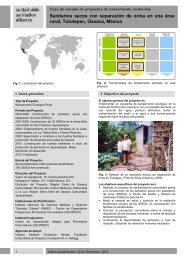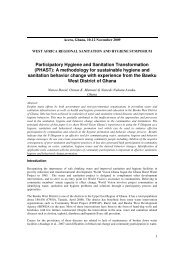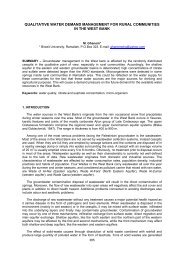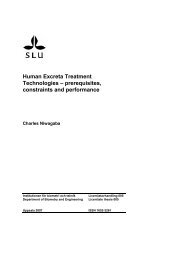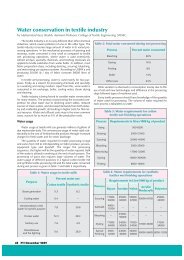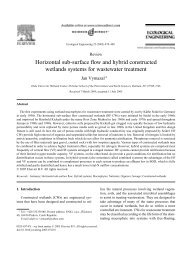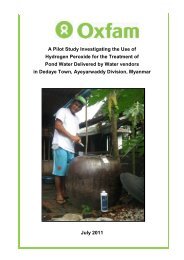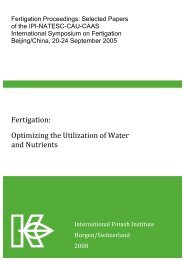Compilation of 13 factsheets on key sustainable sanitation ... - SSWM
Compilation of 13 factsheets on key sustainable sanitation ... - SSWM
Compilation of 13 factsheets on key sustainable sanitation ... - SSWM
You also want an ePaper? Increase the reach of your titles
YUMPU automatically turns print PDFs into web optimized ePapers that Google loves.
and <strong>on</strong>going instituti<strong>on</strong>al support during the O&M phases.<br />
Training is another very crucial aspect as even the most<br />
inexpensive or sophisticated technologies eventually fail if<br />
they are not accompanied by a trained service provider.<br />
One <str<strong>on</strong>g>of</str<strong>on</strong>g> the challenges for improving sanitati<strong>on</strong> in low and<br />
middle income countries involves acquiring a sound<br />
knowledge <str<strong>on</strong>g>of</str<strong>on</strong>g> the wide range <str<strong>on</strong>g>of</str<strong>on</strong>g> sanitati<strong>on</strong> opti<strong>on</strong>s to ensure<br />
informed decisi<strong>on</strong> making. The most feasible sanitati<strong>on</strong><br />
systems and technologies - for the different habitats in<br />
urban and rural areas, which can achieve the objectives <str<strong>on</strong>g>of</str<strong>on</strong>g><br />
improved health, changed hygiene practices, minimal<br />
impact <strong>on</strong> the envir<strong>on</strong>ment, improved quality <str<strong>on</strong>g>of</str<strong>on</strong>g> life, and are<br />
best suited to the site specific c<strong>on</strong>text - can be chosen<br />
when decisi<strong>on</strong> making is informed.<br />
Comm<strong>on</strong>ly asked questi<strong>on</strong>s when faced with deciding <strong>on</strong> a<br />
sanitati<strong>on</strong> opti<strong>on</strong> are: What are the available sanitati<strong>on</strong><br />
systems? Which sanitati<strong>on</strong> systems are appropriate for<br />
which kind <str<strong>on</strong>g>of</str<strong>on</strong>g> faecal waste inputs? What kinds <str<strong>on</strong>g>of</str<strong>on</strong>g> waste<br />
products are produced from the technologies that transform<br />
waste inputs? This factsheet summarises and highlights<br />
previous work c<strong>on</strong>ducted by various authors who worked <strong>on</strong><br />
the categorisati<strong>on</strong> <str<strong>on</strong>g>of</str<strong>on</strong>g> sanitati<strong>on</strong> systems (Cruz et al., 2005;<br />
IWA, 2005; Tilley and Zurbruegg, 2007; DWA, 2010; Tilley<br />
et al., 2008).<br />
3 Systemising sanitati<strong>on</strong> systems<br />
The main objective <str<strong>on</strong>g>of</str<strong>on</strong>g> a sanitati<strong>on</strong> system is to protect and<br />
promote human health by providing a clean envir<strong>on</strong>ment<br />
and breaking the cycle <str<strong>on</strong>g>of</str<strong>on</strong>g> disease transmissi<strong>on</strong>, as well as<br />
to preserve the dignity <str<strong>on</strong>g>of</str<strong>on</strong>g> users - particularly women and<br />
girls. In order to be <strong>sustainable</strong>, a sanitati<strong>on</strong> system has to<br />
be not <strong>on</strong>ly ec<strong>on</strong>omically viable, socially acceptable, and<br />
technically and instituti<strong>on</strong>ally appropriate, it should also<br />
protect the envir<strong>on</strong>ment and the natural resources (SuSanA,<br />
2008).<br />
A sanitati<strong>on</strong> system - c<strong>on</strong>trary to a sanitati<strong>on</strong> technology -<br />
c<strong>on</strong>siders all comp<strong>on</strong>ents required for the adequate<br />
management <str<strong>on</strong>g>of</str<strong>on</strong>g> human excreta. Each system represents a<br />
c<strong>on</strong>figurati<strong>on</strong> <str<strong>on</strong>g>of</str<strong>on</strong>g> different technologies that carry out different<br />
functi<strong>on</strong>s <strong>on</strong> specific waste inputs or waste products. The<br />
sequence <str<strong>on</strong>g>of</str<strong>on</strong>g> functi<strong>on</strong>-specific technologies through which a<br />
product passes is called a “Flowstream”. Each system is<br />
therefore a combinati<strong>on</strong> <str<strong>on</strong>g>of</str<strong>on</strong>g> inputs, functi<strong>on</strong>-specific<br />
technologies, and products designed to address each<br />
flowstream from origin to reuse or adequate disposal.<br />
Technology comp<strong>on</strong>ents exist at different spatial levels, each<br />
with specific management, operati<strong>on</strong> and maintenance<br />
c<strong>on</strong>diti<strong>on</strong>s as well as potential implicati<strong>on</strong>s for a range <str<strong>on</strong>g>of</str<strong>on</strong>g><br />
stakeholders. A system can include waste generati<strong>on</strong>,<br />
storage, treatment and reuse <str<strong>on</strong>g>of</str<strong>on</strong>g> all products such as urine,<br />
excreta, greywater, organic solid waste from the household<br />
and agricultural activities such as manure from cattle at or<br />
near the source <str<strong>on</strong>g>of</str<strong>on</strong>g> waste generati<strong>on</strong>. However, the<br />
requirement to effectively c<strong>on</strong>tain the wastes and prevent the<br />
spread <str<strong>on</strong>g>of</str<strong>on</strong>g> diseases and the polluti<strong>on</strong> <str<strong>on</strong>g>of</str<strong>on</strong>g> the envir<strong>on</strong>ment can<br />
<str<strong>on</strong>g>of</str<strong>on</strong>g>ten not be solved at the household level al<strong>on</strong>e.<br />
Households “export” waste or envir<strong>on</strong>mental c<strong>on</strong>taminants<br />
generated by the wastes to the neighbourhood, town, or<br />
downstream populati<strong>on</strong>. In such cases, it is crucial that the<br />
sanitati<strong>on</strong> system is extended to include these larger spatial<br />
areas and take into account technology comp<strong>on</strong>ents for<br />
storage, collecti<strong>on</strong>, transport, treatment, and discharge or<br />
reuse at all levels.<br />
Figure 2: System template providing a schematic overview <str<strong>on</strong>g>of</str<strong>on</strong>g> the specific inputs <str<strong>on</strong>g>of</str<strong>on</strong>g> a sanitati<strong>on</strong> system (left column), their transformati<strong>on</strong> in the<br />
four functi<strong>on</strong>al groups “user interface”, “collecti<strong>on</strong>”, “transport” and “treatment“, the specificati<strong>on</strong> <str<strong>on</strong>g>of</str<strong>on</strong>g> two outputs for the fifth functi<strong>on</strong>al group<br />
“reuse/disposal” (in this example “nutrient reuse in agriculture”) (source: Luethi et al, 2011).<br />
Sanitati<strong>on</strong> systems, technology opti<strong>on</strong>s, hygiene and health: Working Group 4 - page 2



